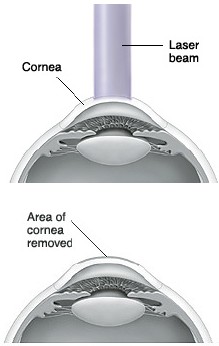Refractive Surgery: PRK
Refractive Surgery: PRK
PRK (photorefractive keratectomy) is a procedure to reshape corneal tissue to help you see better without glasses or corrective lenses. This method uses an excimer laser. This laser produces a concentrated beam of cool ultraviolet (UV) light. Each pulse of the laser can remove a tiny part of corneal tissue. PRK can be used to treat the following conditions:
Farsightedness (hyperopia)
Nearsightedness (myopia)
Blurred vision caused by an abnormally shaped cornea (astigmatism)
What to expect
Before treatment, you may be given medicine to help you relax.
Eye drops numb your eyes. A device is used to keep your eyes open.
A small surgical tool or the laser is first used to remove the central part of your cornea (the epithelium). Laser treatment lasts for 10 to 90 seconds.
After laser treatment, you will wear a contact lens as a bandage for a few days. This protects the cornea as it heals.
For a few days after the procedure, your vision may seem worse. It should begin to improve in about 5 days, and become stable in about 6 months.
Cons of PRK
Mild to moderate pain after surgery
Longer vision recovery than LASIK
May need to use eye drops for 3 months or longer
Risk of corneal scarring or haze
Risk of short-term (temporary) or long-lasting (permanent) dry eye
Risk of night vision problems, such as halos, glare, or starbursts
Risk of undercorrection or overcorrection
Risk of losing your best corrected vision
Pros of PRK
No risk of flap problems
Better for people with thin corneas, previous glaucoma surgery, mild corneal scars, or other cornea problems
Updated:
March 21, 2017
Reviewed By:
Bogus, William J., OD, FAAO,Griggs, Paul B., MD,Image reviewed by StayWell medical illustration team.
